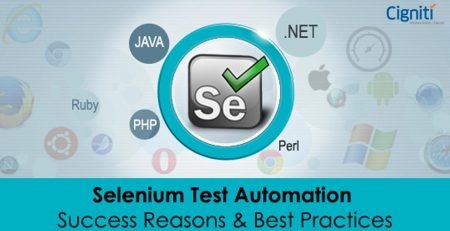Migrating to Selenium? Know Your Costs, Challenges & Options
|
Listen on the go!
|
Enterprises are getting digitally powered and are responsible for ensuring digital empowerment for its customers/users. Insights from Gartner’s CIO Agenda (2016) Survey data suggests that digitalization is growing. Private sector CIOs expect that in the next five years digital revenues will grow from 16% to 37%, while the public sector expects a rise from 42% to 77% in digital processes.
In this pressing scenario, it is imperative to make your web applications robust and ensure desired functionality as well as GUI (Graphical User Interface). This will further guarantee the application’s performance in all possible scenarios.
Test Automation has been enabling enterprises to accelerate the testing process and attain maximum test coverage. Enterprises are increasingly automating their test efforts, for:
- Code Reusability
- Maximum Test coverage
- Low maintenance cost
- Least Manual intervention
- Ease of Reporting
In practice, Test Automation can be compared to an instruction manual of a console-based game. If installed meticulously with proper instructions, it will prove to be an engaging interface between the user and the machine. It is a constructive blend of various guidelines, coding standards, concepts, processes, and reporting mechanisms to execute effective automation testing.
Today, teams are increasingly moving towards licensed/open source Frameworks instead of considering a ‘build your own Framework’ approach.
With a clear view to cut costs and bring efficiency, companies are increasingly inclining towards Open Source automated testing tools than investing in commercial/licensed testing tool that implies increased costs. Open source testing instruments are loaded with significant features that enable swift automation testing of Web portals and software applications.
Why Selenium? Gauging the value.
That said, Selenium is getting popular as an automated testing tool for testing Websites, specifically for their functionality and GUI. There are some top significant reasons why enterprises prefer to use Selenium for Test Automation.
- Capability to operate on almost every Operating System (OS)
- Being an open source testing tool, it is cost-effective for automation testing
- Supports multiple languages, namely, Python, Pearl, Ruby, PHP, .NET, and Java
- Language used for developing the program need not be the same as the language used for the web application/website
- Supports multiple browsers – Opera, Safari, Chrome, IE 6, 7, 8, and Mozilla Firefox
- Has an active developer community, for active training with reduced costs
- Capability to execute parallel tests by using various browsers across various devices, which helps cut down the test execution for big projects (when in progress)
- With Selenium Integrated Development Environment, it gets easy to quickly create simple tests
- Being cohesive, it provides an easy to use interface for developing automated tests as against any other testing tool
- Provides components, which can be selected on the basis of complexity of the Web page
- Provides scalability and sustainability in the long term
Migrating to Selenium? Know the challenges
Thanks to the freeware, enterprises are moving towards Open Source Test Automation tools, instead of investing in expensive commercial testing tools, like HP QTP, UFT, or TestComplete. Selenium Web Driver is by far the top choice for automation of browser based applications, supports execution multiple browsers, and integrate with tools for Continuous Integration.
If you are considering migration to an Open Source tool like Selenium for Test automation, you need to re-develop the scripts in Selenium from ground zero. In the present scenario, test automation scripts developed using licensed tools cannot be directly converted to Selenium.
A strong testing partner with decades of expertise can help strategize the migration and automate the process to convert recorded QTP scripts to Selenium scripts, by reducing the costs and time.
Automating your Selenium Migration process with an effective Selenium Migration Tool can help surge the conversion rate to almost 70%. By implementing automation, all the functional libraries, reusable scripts, and various calls can be converted quickly. This helps organizations to evade recurring licensing costs, upgrade costs and soaring service costs.
Know your options
While the market is flooded with commercial/licensed Test Automation Frameworks, Open Source Frameworks are getting popular. Thanks to the cost-effectiveness and customization that it offers.
There is an array of Open Source Frameworks in the market, to name a few – Serenity (Formally Thucydides, Robot Framewor, RedwoodHQ, Sahi, Galen Framework, and Gauge.
While these options exist, Selenium is by far the most popular and chosen one not just for Web Applications, but also for Mobile Application Testing. It is a cost effective tool, as it is an open source tool with no licensed costs and its features can be compared with HP Quick Test Pro (QTP), a commercial tool in the same category.
Selenium is evolving as a robust web application testing framework. With its open source licensing and the support that it offers to multiple browsers, languages, and platforms, it has become an integral component for various browser automation tools. Selenium and Selenium WebDriver are by far the most advanced test automation tools in the marketplace.
Referring to marketplace, vendors are increasingly stepping up and flawlessly integrating with Selenium for enhanced functionalities that enable you to accelerate your testing efforts.
To sum up
Gartner’s latest report on Test Automation tools (Magic Quadrant) does not mention Selenium, as the report focuses on tools that Gartner states “key areas”. Nonetheless, the industry has validated that open innovation is here to enable enterprises, as they would be able select the best and effective tools for every varying project with varying requirements.
Selenium is being implemented by popular online enterprises like Google and Facebook for testing their web interfaces. While it delivers an effective mechanism to generate test scripts, ensures functionality and brings reusability for the test scripts, Selenium Automation requires substantial technical expertise and support of third party tools to get completely functional. Moreover, with its ease of implementation at the GUI level, testers can fall into the trap of overusing the Framework for testing lower layers in the software stack.
Cigniti is a Silver level sponsor of Selenium and authorized Sauce Labs partner. We have been providing strategic consulting services to clients in implementing test automation using Selenium. Our Test Automation CoE has been collaborating with global clients to jumpstart their automation efforts and implement a proven platform to bring sustainability and reduce maintenance.
Cigniti’s IP driven tools and test automation services maximize the benefits of utilizing Selenium WebDriver. Our 300+ Selenium test automation experts contribute regularly to the growing Selenium open source test automation community.





Leave a Reply